As most of you know recently we had our sow, Missy, butchered. The butcher gave us all of her fat. which I rendered into lard. I thought I would share that process because it’s so easy, and people don’t think of lard as a great source of healthy fats anymore.
The fat usually comes in bags of large, thick, strips:
To enable the fat to melt quicker, I cut it into 1-2 inch pieces. It seems to cut better and easier if the fat has been chilled and is less rubbery in consistency:
Then I put it all into one or more simmering pots. (Any stock or soup pot or even large sauce pan seems to work fine):
I place the pot onto a burner and turn it to the lowest setting. Some people might prefer to put a heat diffuser under the pot to more evenly distribute the heat and protect the fat from burning. I don’t have one yet, so I just put the pot right on the burner. As the fat heats up, it will turn rubbery and creamy white in texture and appearance:
As the fat continues to melt, it will become increasingly bubbly. Rendering fat is not something you can start and come back to in a few hours. Due to the fact that it is very hot and can burn easily, you want to stir it fairly often (not constantly, but you want to be nearby enough to keep an eye on it). Also, please be careful not to look directly down into the pot as the fat is extremely hot and can pop up into your face and burn. I also don’t usually put a cover on the pot, as the condensation drops down into the fat and causes more popping if I do. But do whatever you prefer and feel is safest:
There will be a point where the bubbling will start to subside after a period of time (a few hours in my experience):
After the bubbling subsides a bit, you will see the pieces of cooked fat called “cracklings” floating in the liquid fat. At this point, the rendering process is close to complete; and you want to watch to make sure your fat doesn’t start to smoke or the cracklings scorch. This makes for burnt lard, which is still usable but not desirable:
I have learned it is better to turn off the heat sooner than later to ensure no burning of the lard. When the bubbling has mostly stopped, I turn off the heat; and the cracklings start dropping to the bottom of the pot:
After a short time, most of the cracklings should sink to the bottom of the pot leaving pure liquid fat waiting to be spooned out and put into hot jars. Some resources will say this process can take up to 18 hours, and maybe I’m doing it wrong, but the method I use seems to only take a few hours per batch. Perhaps I’m not getting all of the liquid out of the fat pieces, but right now I don’t have the luxury of more time, and I’m not sure how one could get much more from letting it simmer a lot longer. And mine always starts to smoke if I leave it longer anyway. So, whatever method works best for you is the best method!
Since the melted fat is EXTREMELY hot, it is best to heat up your jars before spooning the fat into them. I take clean jars, place them on the rack in the oven, and turn it on to warm or a little higher, and let them heat up while I’m prepping everything else. Then when I am ready for the jars, they will be nice and warm/hot to accommodate the very hot liquid:
To prevent little tiny particles of cracklings to get into the lard, I filter the liquid while spooning it into the jars. You can use whatever method works best for you (cheesecloth, paper towel, mesh strainer with cloth, etc.) I recently found that a goat milk filter works great, so I’ve adopted that method. I place the filter into the canning funnel that fits into the mouth of the canning jar, and it makes a nice filtering setup:
Since most of the cracklings have sunk to the bottom, it is very easy to ladle out most of the liquid fat into the jars:
I tip the pot to get the last of the liquid out:
All that is left are the cracklings after spooning out the liquid fat. I munch on a few as I process the fat but don’t usually do anything with them except feed them to the chickens. However, some people I’m told put salt and seasonings on them for a tasty treat.
I try to press out as much fat from the crackings as I am able, but there is still a bit left in them. I used an antique lard press a few times but came to the conclusion that the amount of extra fat I was getting was not really worth the mess the press made and the resources required for clean-up. But some people may be very loyal to them. It’s certainly a personal choice:
And here is the rendered fat ready to be sealed and either stored in a cool place or canned and stored. I usually end up yielding several quarts of lard when we butcher a pig, and since Dave and I don’t go through it quickly, I like to pressure can it. I was surprised that there is VERY little information on the Internet about canning lard. I probably way overdo it, but I can it for 90 minutes as if I were canning meat, because I can’t find any reliable information otherwise. So I can it a lot to ensure its safety. If you can reliably provide additional information from your own lard canning experience, I am all ears and would greatly appreciate it. Until then, I’ll play it safe. I have not experimented to see how long an uncanned jar of lard will last down in our root cellar but hope to remember to try it next time. But I would hate for all those quarts to go rancid from not canning them before we are able to use them. This way they are good for years.
The rendered lard hardens up and turns white (or a little darker depending on the type of fat rendered and if it got burned in the process). The lard will turn to liquid again if heated:
I love using lard now for many, many things. I use it to pop popcorn, on bread for grilled cheese sandwiches and toast, as an oil in recipes and baking, etc. It may sound icky but it’s a wonderful and tasty organic animal fat. My friend Shannon, once again, has a great blog post on healthy fats, and lard is right up there at the top of the list. I had to be re-educated on the benefits of healthy animal fats, and I’m assuming most people think it’s very unhealthy, but I believe we truly need these healthy fats in our diets. I hope you take a few minutes to research it for yourself.
Also, I’m sure most people may not have a freshly butchered pig “hanging around,” but I’m told many local butchers and processing places will either give away or sell their fat, so you may want to check that out in your area.
Lastly, if you don’t have a copy already, I highly recommend the Encyclopedia of Country Living by Carla Emery to get you started on rendering lard. It is truly a survival book for those of us just starting out on our domestic, animal husbandry adventures.
We also currently make homemade fat lamps with our lard, and I hope to experiment making soap from lard as well and will let you know how it goes, Lord willing. You can also render lard out of beef tallow (fat), so maybe sometime we’ll be able to butcher one of our Longhorns and I’ll be able to share that adventure as well. As always we are so very grateful for God’s provision to have this homemade healthy fat resource.
Susan
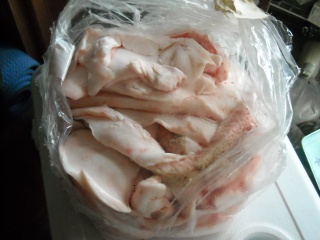
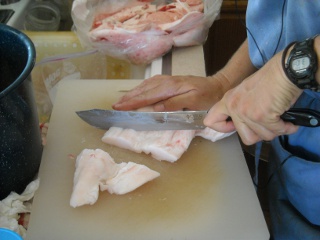
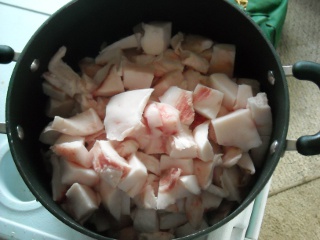
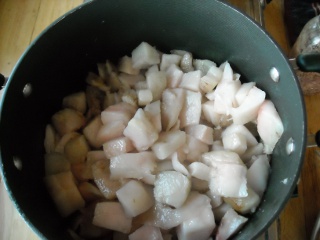
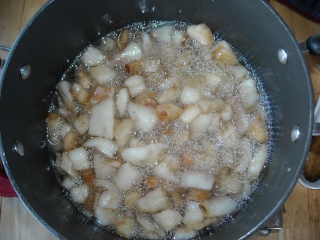
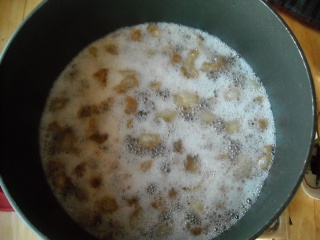
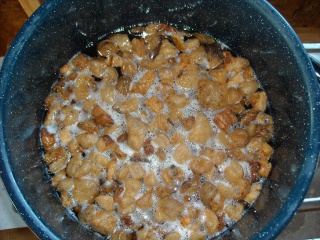
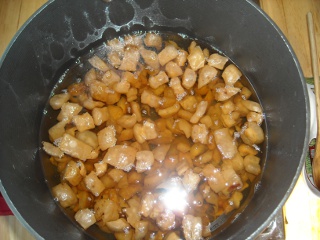
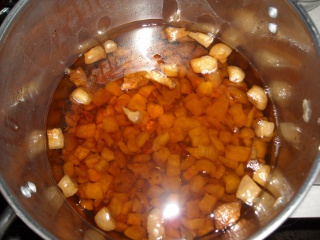
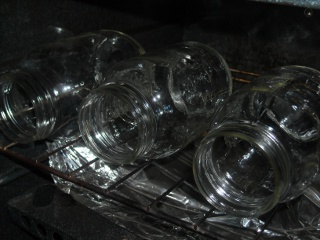
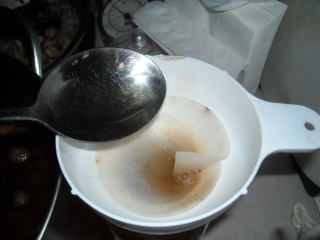
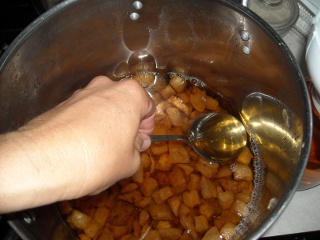
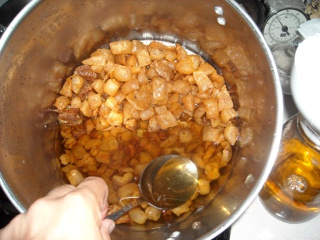
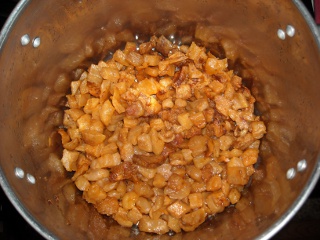
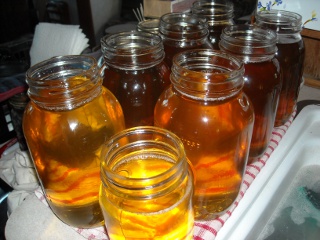
I like to keep at least some of the cracklings. I don't press them, just jar them up with any residual lard that's with them. Then, I use them in place of oil in my cornbread, using just a bit more than the usual amount of oil. (I make cornbread out of my head, not with a recipe, so I can't say just how much I use.) It makes really rich yummy cornbread.
Thank you for showing us how you do this, Susan. I have only rendered lard once and I used a slow cooker, though I think it may have overheated it a bit. It makes the best pie crust on its own or cut with half butter, in our opinion.
I read recently that up until the invention of Crisco and the mass-marketing of vegetable oils, lard was THE cooking fat in this country and many others. Of course Crisco did a nice little smear campaign and lard was unable to fight back.
I wonder how people preserved lard before canning came along. Perhaps just the cooler temperatures up here in the north, but lard was very widely used in the south too I believe.
Anyways, thanks again for sharing, Susan. Always a blessing in my journey.
Thanks much for your comments, Judy and Shannon! You both are a blessing to me.
That corn bread tip sounds delicious – I hope to try it next time!
Thanks for the post. I had no idea that it took as long as it did. I think I would want to do that outside if I could. What does it smell like?
-Todd
Hello Todd! And thank you for your comment. I can understand how it could appear like a smelly, messy job but it's really rather tidy and I haven't noticed much of a smell at all. I guess it smells a little like frying pork. But if you have facilities to do it outside that would be the best of all worlds (unless it's raining or snowing, etc) 🙂
If you ever do render lard, I'd love to hear how it goes for you.
Susan
Thanks Susan,
Until we are ready for pigs, we have a good butcher who I am sure could provide us with some fat to render. I am sure the girls would be excited. The "Little House on the Prairie" books talk about cracklins, so that should add some appeal. We have also talked about making some fat lamps ever since I first saw your post about them a year or more ago. Blessings to you and the hard work it looks like you all have been putting in to the Bunker's cistern.
Todd
you two seem to really be interested in following Christ, as do i, but i cannot understand how you miss the part of the swine being an abomination to GOD. im not trying to judge but to enlighten. Leviticus 11:7
And the swine, though he divide the hoof, and be clovenfooted, yet he cheweth not the cud; he is unclean to you. our Lord above all knows what was and still is good and not good for us.
Anonymous,
We believe this was done away with in Acts 10:9-15: "9 On the morrow, as they went on their journey, and drew nigh unto the city, Peter went up upon the housetop to pray about the sixth hour: 10 And he became very hungry, and would have eaten: but while they made ready, he fell into a trance, 11 And saw heaven opened, and a certain vessel descending upon him, as it had been a great sheet knit at the four corners, and let down to the earth: 12 Wherein were all manner of fourfooted beasts of the earth, and wild beasts, and creeping things, and fowls of the air. 13 And there came a voice to him, Rise, Peter; kill, and eat. 14 But Peter said, Not so, Lord; for I have never eaten any thing that is common or unclean. 15 And the voice spake unto him again the second time, What God hath cleansed, that call not thou common."
While we believe this had the more obvious spiritual fulfillment of the Gospel being preached to the Gentiles/uncircumcised/"unclean" as well as Jew/circumcised/"clean", we also believe that it should be taken literally, 1) for why would God give a command, even as an example of a spiritual lesson, that would be breaking another of His commands if He wasn't abrogating the original command; and 2) because the original command of clean and unclean was "type" and shadow of Jew and Gentile respectively, and now with the fulfillment of the "type" in the "antitype" being declared "clean," the type and shadow is no longer needed nor in place.
Also, Christ foreshadowed this in Matt 15:11: "Not that which goeth into the mouth defileth a man; but that which cometh out of the mouth, this defileth a man."
— David
I have a copy of The Victory Cook Book from 1943. While it does not go into detail about how to store lard (also referred to as shortening in most of the book) it does cover making, use, care, clarifying and some storage tips. It said that to store it to keep it in a dry, cool, dark place away from air. Most other times when they suggest these conditions they recommend a root cellar if you have one. I have rendered fat before and had no problem putting the lard into warm canning jars and covering with a ring and lid. As the mixture cools it will seal the jar and it does not go rancid.
To improve the flavor and texture of lard it is recommended to add 1/2 cup of milk to 1 pound of fat. Then render it in a double boiler. Sweet, sour, or butter milk may be used.
If the cracklins have a good flavor they may be substituted for other fats in other dishes. Notably, corn meal and graham flour mixtures. It also works well in hash brown potatoes, corn meal mush that is to be fried, and any kind of baked hash.
If you burn/smoke your lard while rendering or it picks up disagreeable flavors thru cooking you should melt it and for each pound or pint add 1 medium sized potato cut in to 1/4" slices. Gradually heat. When the fat ceases to bubble and the potatoes are well browned, strain the fat thru several thicknesses of cheese cloth, and set aside to cool. When ready to use scrape away and discard the sediment from the bottom of the cake. Potato helps clarify and purify the lard.
David G,
Thank you very much for taking the time to share your insight and knowledge. I really appreciate the additional information.
I have burned a few batches of lard since I started rendering it and have set those batches aside to burn in our fat lamps. But now that there may be a way to salvage them by purifying and clarifying with the potatoes I hope to try your suggested method. Thank you!
Susan
The lard and the cracklings look delicious!!
Google led me here, I'm looking for how people preserve lard. Was thinking of water bathing cans, since my pressure cooker doesn't actually pressurize for preserving (all the books I see have much larger pots and different gages on its lid) but am seeing you pressure can them. 🙁
Still, those crackling pictures make me want to render some anyway!
Hello Matildah! And thanks for stopping by! You know I think you could preserve your lard just fine with a water bath canner. Since I usually end up canning several (over 10) quarts of lard at one time I like to go the ultra safe route and pressure can them so I know they will last several years that way. But if you think you'll be using yours within a reasonable amount of time, I would estimate the water bath would work fine. That's my opinion. I hope your processing goes well whenever you decide to try it.
Susan
Lard oil is used in the preservation of sign painting brushes . Ive been unable to find directions on turning lard into an oil and was hoping to be pointed in the right direction. Thanks a lot
Hello Mr. Selsor!
Thank you for taking the time to comment! I didn't know that lard oil is used as a brush preservation method – it makes sense, though. And pressure canning oil is a great way to ensure it does not go rancid before you use it. I am still opening jars of canned lard that are 4-5+ years old and they are completely fine. It does turn solid below a certain temperature, probably around 70-75 degrees. But I'm glad to know it provides another option for preserving brushes for you.
Thank you again for saying hello!
Susan
Hi, I just stumbled across your blog, and am enjoying what I am reading. Thank you for making the effort to put out a good, informative blog!
Regarding your treating lard as a meat and pressure canning it, that's exactly right. I know an older lady who grew up on a farm where they canned lard from butchered pigs, and they canned it in half gallon jars. This is what she said (remember she's referring to half gallon jar size):
After rendering and straining into canning jars the lard has to be cooled completely before beginning the canning process and you have to leave at least ONE INCH of headroom in the jar.
The stuff has to be canned just as you would can any meat – Pressure canner at 10 pounds pressure for 2 hours If you have a big pressure canner that can give you RELIABLE 15 pounds of pressure you can process it for 90 minutes.
May God continue to bless your life.
Hi Beth!
Thank you for stopping by and taking the time to leave a comment! I appreciate your kind words and sharing your knowledge.
I'm curious, do you know why your friend says to cool the lard completely before canning it? I've always canned it when it's hot from rendering but am always open to new information and better processing suggestions.
Thank you again! And may God bless you.
Susan